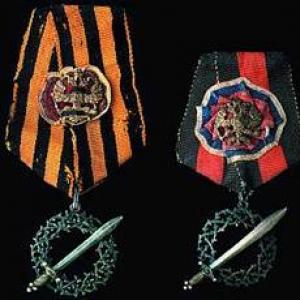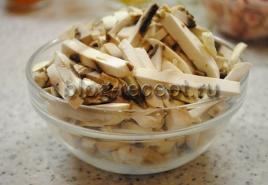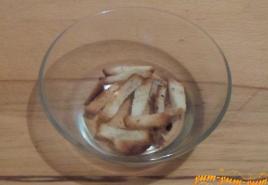The large rocker dragonfly is a destroyer of blood-sucking insects on land and in water. The large rocker dragonfly is a fighter of blood-sucking insects on land and in water. What animal is called the rocker?
Night butterflies of Vyatka
Master class “Macro photography of mushrooms”
Archive of records by day.
| Mon | W | Wed | Thu | Fri | Sat | Sun |
|---|---|---|---|---|---|---|
| 1 | ||||||
| 2 | 3 | 4 | 5 | 6 | 7 | 8 |
| 9 | 10 | 11 | 12 | 13 | 14 | 15 |
| 16 | 17 | 18 | 19 | 20 | 21 | 22 |
| 23 | 24 | 25 | 26 | 27 | 28 | 29 |
| 30 | 31 | |||||
Site headings
- (42)
- (130)
About Me:
Born in Yaransk, Kirov region. I have been interested in photography since 1975, I have been photographing almost my entire life. Lately I've only been shooting macro. Member of the Union of Photographers of Russia. Member of the Macro Club since 2008. Organized three exhibitions in local history museums. Participant of thematic exhibitions at the Darwin Museum in Moscow. Participant of the exhibition “We are alive”, Moscow 2012. Prize-winner of the photo competition “WILDLIFE OF RUSSIA-2012” by the magazine “National Geographic Russia”. Laureate of the Golden Turtle 8 competition. Finalist of the competition "Primordial Russia" 2013. Finalist of the competition "Life in the Rhythm of Sports" at the Darwin Museum. Participant in the Macroclub photo exhibition for children at the Golden Turtle festival in the Central House of Artists. Participant of the exhibition “WILDLIFE OF RUSSIA-2014” of the magazine “National Geographic Russia”. Participant in the competition Primordial Russia 2014.
Site statistics
Links
- 35 Photos My works on the site
- Photosight Portfolio
- My Macroclub I'm in the Macroclub
- Union of Photographers of Russia Member of the SFR
Weather
- 12.06.2019
The brown hare is a fairly large individual, growing up to 68 cm in length and weighing approximately 7 kg. The main feature of all hares is their long wedge-shaped ears, 9-15 cm, thanks to which they are able to hear at a great distance, but their sense of smell and vision, alas, fails. During times of danger, the rodent shows the greatest aggression, attacking, thereby scaring […]
- 04.11.2017
On November 4, the night of museums, my small macro-exhibition was opened. The exhibition fits perfectly into the biology department. Thanks to the museum staff for the excellent organization!
- 18.05.2017
This year, the pilgrims began to emerge from the ooteca very early. But they have every chance of becoming sexually mature and creating a Vyatka population.
- 03.05.2017
The spawning of the frog Rana arvalis is always a spectacular sight. It is very interesting to watch how frogs dance in circles, making rumbling sounds as they do so. The result of their activity is that the caviar is already ripening with might and main under the cold May sun. This year, due to the extremely cold spring, spawning has shifted from April to May.
- 01.04.2017
To keep your cat occupied for a very long time, make a simple toy - find an unnecessary box, cut holes in it for the paws and place some kind of ball or small favorite toy of your cat there. Masya is working :)
- 05.02.2017
The predominant plumage color of waxwings is a delicate, velvety-matte grayish-brown tone, with a pink wine tint. The wing coverts are black with white tips, the flight wings are black with whitish spots on the outer web and a yellow spot on the inner. The secondaries have a white spot at the apex and unique outgrowths, characteristic only of waxwings, of a beautiful coral-red color. The tail is gray at the base and has a black […]
- 04.02.2017
In the old days they noticed that if a bullfinch arrived, then winter would come soon. But, oddly enough, in our city bullfinches appear when winter has already arrived, and in February you can open the window and hear a quiet bullfinch whistling. And it happens like this: you leave the house in the morning - there are unsmiling people around, everyone is in a hurry somewhere, and suddenly your gaze falls on [...]
- 02.12.2016
The plot will tell you about the mating behavior of the Common firefly or the Ivanovo worm. The video was filmed in the Vsevolozhsk district of the Leningrad region. Author and presenter - Candidate of Biological Sciences Pavel Glazkov. Several of my photographs were used in the film.
- 02.12.2016
The plot will tell you about the grouse lek - a unique marriage social structure with a clear distribution of roles and territorial organization. The video was filmed in the Vyborg district of the Leningrad region. Author and presenter - Candidate of Biological Sciences Pavel Glazkov. Several of my photographs were used in the film.
- 29.11.2016
Oncidium is a genus of herbaceous perennials from the Orchidaceae family, numbering over 300 species. Most of them are epiphytes; lithophytes and terrestrial plants are less common. The natural distribution area covers the forested areas of South and Central America, Mexico and the West Indies. Despite the great species diversity, several main characteristics can be identified that are common to all representatives of the genus. All […]
All photographs on the site are protected by copyright law.
For questions regarding the use of images, please contact [email protected]
(Aeschnidae)
Large, variegated dragonflies are one of the most beautiful representatives of the order. The eyes on the crown of the head touch. The wings at rest are directed to the sides. Rocker arms can fly for hours without rest. At this time, they often fly far from bodies of water. Females lay eggs in living or dead plant tissues, dipping the end of their abdomen into the water. Larvae are active predators, sometimes attacking even fish fry. In some species, development is completed in 1 year, in others it lasts up to 4 years.
(Aeschna grandis)
The main body color is brownish-red. The wings are golden brown, with reddish veins. The chest is on top between the wings with 4 blue spots, on the sides - with yellow stripes. The abdomen of males has blue spots on the sides and white spots on top. In females, the spots on the abdomen are light gray. Body length 70 - 80 mm, wingspan up to 105 mm.
Dragonflies are found from late June to September. Their flight is characterized by the fact that they often glide. They fly not only during the day, but also after sunset. Females lay eggs in dead plant tissue submerged in water, or in accumulations of dead plant parts near the shores of water bodies.
The larvae reach a length of 50 mm and develop in 2–3 years. They prefer stagnant or low-flowing water bodies. They live among aquatic vegetation.
12. Watchman-overlord(Apah imperator)
The eyes are greenish-blue above and yellow-green below. The chest is greenish, without stripes. Females have golden-yellow wings, while males have colorless wings. In males, the abdomen is blue, with large blackish-brown spots; in females, it is bluish-green, with larger spots, with a reddish-brown tint. Body length up to 80 mm, wingspan up to 110 mm.
Dragonflies fly from mid-June to August. They can be found along the banks of small ponds and other standing and low-flowing overgrown bodies of water. Females lay eggs mainly in dead, submerged parts of plants. The larvae live among aquatic vegetation. Within a year they reach a length of 60 mm and complete their development.
13. White-haired rocker(Brachytron hafniense)
The dragonfly is covered in dense whitish hairs, hence its name. The eyes of males are blue, those of females are yellowish-brown. The chest is brownish-red on top, with 2 wide greenish-yellow longitudinal stripes. The sides of the chest are green, with 2 oblique black stripes. Legs are black. The abdomen of males is black, with blue spots and narrow transverse green stripes. Females have yellow spots on their abdomen.
Body length up to 65 mm, wingspan up to 80 mm.
Dragonflies fly in May - July. For laying eggs, they choose small stagnant and low-flowing water bodies, including swampy ones.
The larvae are massive and live among dead parts of aquatic plants. They develop very slowly and overwinter three times.
14. Blue rocker(Aeschna cyanea)
The eyes of males are greenish-blue, those of females are yellowish-green. On the forehead there is a characteristic black spot in the shape of the letter T. The chest is brown on top, with 2 wide green longitudinal stripes, on the sides it is green, with a black pattern. Males have a black abdomen, with green dorsal and blue lateral spots; on the last abdominal segments all spots are blue. Females have a brownish-red abdomen with green spots or light gray with light blue spots. Body length 65-80 mm, wingspan up to 110 mm.
Dragonflies are found from mid-June until late autumn. Females often fly in the evenings. They prefer large standing reservoirs, ponds and overgrown lakes.
The larvae live among aquatic plants. The development of larvae lasts 2 years. By the end of development they reach a length of 50 mm.

The larvae of the rocker, Aeschna, live in stagnant bodies of water among plants and at the bottom. The length of the larvae reaches 35-45 mm. The body is thick and dense.
The head is large, tightly fused with the body. The antennae are short and seven-membered. The compound compound eyes are large. The mask is flat, the median lobe on the inner side is without long setae, its anterior margin is convex, armed with short hairs; lateral lobes without setae, large movable tooth; When folded, the mask does not reach the base of the legs of the last pair. On the sides of the first thoracic segment there are paired lateral projections, the shape and size of which vary in individual species. The abdomen is large, widened in the posterior half, without teeth on top; the lateral edges of the sixth to ninth segments are elongated into lateral spines. The length of the anal pyramid is equal to the total length of the last two abdominal segments.

The larvae of our most common Aeschna species differ from each other in the following characters:
Both lateral protrusions of the first thoracic segment are the same size or the anterior one is larger than the posterior one
Both side protrusions are sharp
The side projections are the same size, there is a notch between them with a right or obtuse angle - Ae. grandis
The front side protrusion is larger than the rear one, the notch with an acute angle is Ae. juncea
One or both side projections are blunt
The lateral projections are poorly developed, the notch between them is shallow - Ae. affinis
Lateral projections are well developed
The recess between the side projections with a right angle is Ae. suapea
The indicated notch with an acute angle is Ae. viridis
The rear protrusion is larger than the front
The anterior projection is sharp - Ae. isosceles
The anterior protrusion is blunt
The anterior edge of the middle plate of the mask is more than twice as wide as the posterior edge - Ae. coerulea (—Ae. squamata)
The anterior margin is more than twice as wide as the posterior margin - Ae. mixta (=Ae. coluberculus)

A-C larva of Aeschna grandis, general view (A), head from the side (B), male anal pyramid (C); D - left lateral projections of the pronotum of the larvae of Aeschna grandis (I), Aeschna juncea (II), Aeschna cyanea (III), Aeschna mixta (IV), Aeschna affinis (V), Aeschna isosceles (VI), Aeshna viridis (VII), M — tracheal system of the Aeschna larva; E - rectal bladder, with tracheal network, Aeschna larvae; G—schematic cross-section through the rectal bladder of an Aeschna larva; 3—tracheal gills of Aeschna larvae.
1 - head, 2 - antenna, 3 - upper lip, 4 - eye, 5 - pronotum, 6 - stigma, 7 - rudiments of wings, 8 - trochanter, 9 - thigh, 10 - tibia, 11 - tarsus, 12 - abdomen, 13 - lateral spines, 14 - anal pyramid, 15 - submentum (chin), 16 - mentum (chin), 17 - lateral lobe, 18 - movable tooth, 19 - anal appendage, 20 - cercus, 21 - cercoid, 22 - accessory plate (male), 23 - dorsal tracheal trunk, 24 - ventral tracheal trunk, 25 - visceral tracheal trunk, 26 - rectal bladder, 27 - rectum, 28 - tracheal gills.
Dragonfly is an arthropod, six-legged insect, belongs to the subclass of winged insects, order of dragonflies ( Odonata).
The Russian name for the insect was formed as a result of the merger of two Old Slavic words: the noun “egoza” (fidget) and the verb “strekat” (jump or jump). This name fully corresponds to the flight pattern of these fast and nimble creatures.




What do dragonflies eat?
By the nature of their feeding, dragonflies are typical predators that catch their prey on the fly. Each individual has its own hunting grounds, which they zealously defend from strangers and, if necessary, fight for them. The main food of dragonflies is flies, mosquitoes, moths and other small flying insects. Large individuals are capable of eating small fish, spiders and frogs.
Dragonfly larvae (naiads) feed on young fish, small aquatic insects, crustaceans, and larvae of flies and mosquitoes. This diet is determined by the aquatic habitat. In addition, they clean the reservoir from decaying remains of animal and plant origin.


Reproduction and development of dragonflies. How is a dragonfly born?
During the mating season, male dragonflies gather in huge flocks and patrol areas located near water bodies.

After fertilization, the female dragonfly flies to a pond and leaves eggs directly in the water, placing them inside underwater or above-water parts of plants.
The number of dragonfly eggs can reach 600 pieces.


The development cycle of dragonflies is incomplete. The transformation into a mature individual occurs without the pupation stage.
The egg stage lasts from 14 to 35 days. After which a naiad larva emerges from the egg and continues to develop under water. The naiad breathes using peculiar gills located in the hindgut. To supply the body with oxygen, the larvae constantly suck water into it through the anus. They push the “waste” liquid out with force and thus move using the principle of a jet engine.


During the larval stage, the dragonfly molts up to 15 times. During growth, wings begin to appear, although at the moment the insect comes out into the air, they are still fragile.
The last change of “skin” occurs on land, and an hour later the dragonfly is ready for its first flight. The larval stage can last up to 3 years, and its duration depends on the type of dragonfly.


The benefits and harms of dragonflies
It is difficult to overestimate the benefits of dragonflies. Both larvae and adults are highly voracious and destroy insects harmful to humans. Dragonflies eat mosquitoes, which is an invaluable benefit for people and animals. On the African continent, these long-winged insects eat Tsetse flies in large numbers. In addition, they themselves become part of the food chain of fish and birds. Also, according to research conducted by the Siberian Federal University, dragonflies help transfer up to 7 kilograms of fatty acids from water bodies to terrestrial ecosystems, which are necessary for the proper nutrition of organisms. However, the excessive appetite of the larvae causes quite a lot of damage to fish farms. They eat not only fry, but also the main food of fish (mosquito larvae, daphnia, etc.).

- In addition to the normal spectrum, the eyes of a dragonfly are capable of perceiving ultraviolet light.
- The ancestors of modern dragonflies appeared on the planet long before the dominance of dinosaurs and were the first creatures to conquer the air.
- Without a sufficiently developed brain, these insects are able to calculate the flight trajectory of the prey with 95% accuracy.
- Entomologists have still not found an explanation for the mysterious flights of a huge cluster of dragonflies across ocean spaces. They make such trips every 6-7 years.
- In Japan, the dragonfly is considered the standard of military valor and courage.
- On the island of Shikoku there is a park called the “Dragonfly Kingdom”. Everything in it is dedicated to this insect. In addition to the variety of species that live here, the design of the fences surrounding the clearings and the railings of the bridges thrown over artificial ponds is made in the “dragonfly” style. In the park's shops you can buy literature dedicated to these insects and see paintings depicting them.

| Green rocker | ||||||||
|---|---|---|---|---|---|---|---|---|
| Male |
||||||||
| Scientific classification | ||||||||
| International scientific name | ||||||||
|
Aeschna viridis |
||||||||
|
||||||||
Biology
Flight time: end of June - beginning of October. Dragonflies are found near lakes, ponds, oxbow lakes and river backwaters with floating hydrophytes. Inhabits stagnant and low-flowing reservoirs with a muddy bottom, with the obligatory presence of thickets of telores, cattails, reeds and shrub vegetation. The species is closely related to the telores, in the leaves of which females usually lay eggs. However, the species also occurs in the complete absence of this plant. Often flies into urban areas. When landing, dragonflies assume a pose with their abdomen hanging down. They hunt near bodies of water, flying no more than 500 m from them. Most active in the evening hours. They spend the night in the crowns of coastal trees and in thickets of aquatic plants. They exhibit territorial behavior - males protect individual areas along the shore of a reservoir. Females lay eggs by descending into the water, while sliding along plant stems. The egg stage lasts about 9 months. The larval development stage lasts 1.5-2 years. They lead a sedentary lifestyle. They feed on the larvae of mosquitoes, mayflies and other insects,







